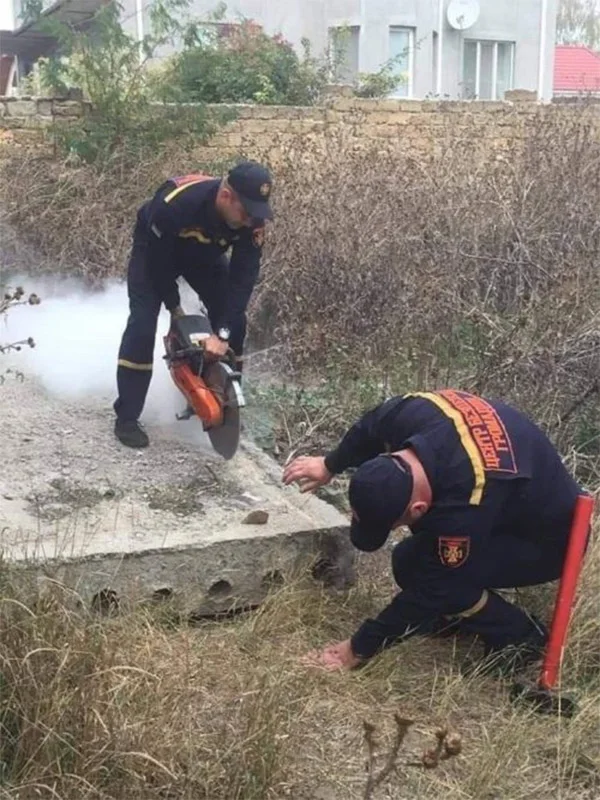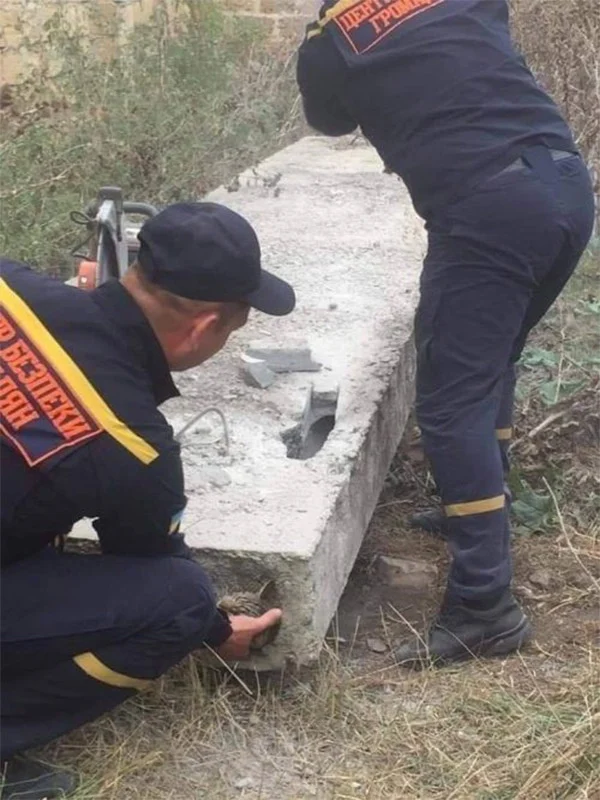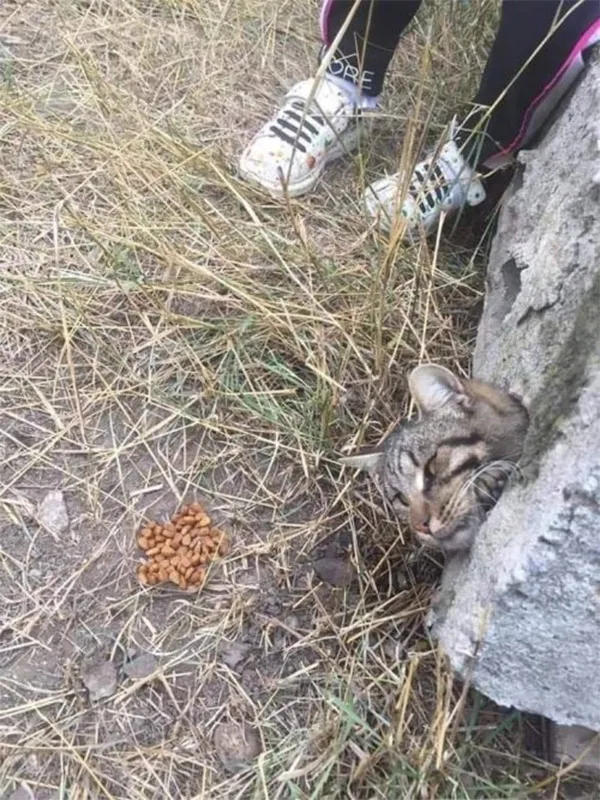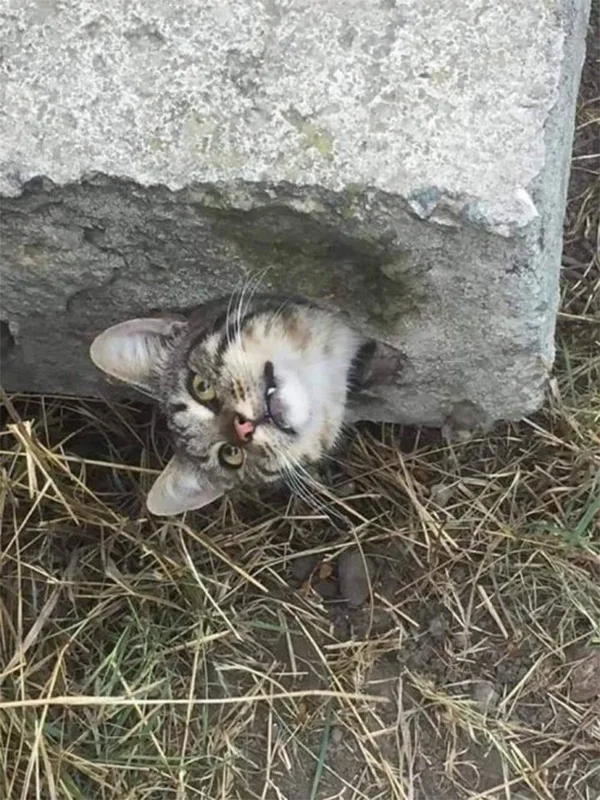Curious Kitten Rescued from Concrete Block Becomes Social Media Sensation.95
Curious Kitten Rescued from Concrete Block Becomes Social Media Sensation
On a quiet Sunday morning, in a small construction site on the outskirts of the city, workers heard a faint cry echoing from a pile of discarded concrete blocks. At first, they thought it was just the wind. But as the sound grew sharper and more desperate, they realized it was the voice of a living creature — a kitten trapped inside a hollow concrete block.
Covered in dust, scared, and barely breathing, the tiny creature meowed for help, its cries muffled by layers of cement. The workers paused everything they were doing. With gentle hands and cautious movements, they began to break open the block, piece by piece. Every chip of concrete removed brought them closer to the fragile life inside.

After nearly half an hour, a pair of trembling paws appeared. Then came a small face — wide-eyed, frightened, and covered in gray dust. The kitten was finally free.
One of the rescuers wrapped the kitten in his jacket and offered it water from a bottle cap. Another took out his phone and began recording the rescue — not for fame, but simply to share a story of kindness in a world that often forgets it.
When the video was uploaded later that day, something incredible happened. Within hours, it spread across social media platforms — TikTok, Instagram, and Facebook — gathering millions of views. People from all over the world were moved by the image of the trembling kitten blinking into the light for the first time.
The comments section overflowed with emotion. Some wrote, “Faith in humanity restored.” Others shared their own rescue stories, creating a wave of compassion that connected strangers through screens.
Soon, animal shelters and rescue groups began reaching out. They offered to take the kitten in, provide medical care, and help it find a forever home. But before that could happen, the workers decided to name the kitten Hope — because that’s what it had become: a small symbol of resilience and trust.

At the veterinary clinic, Hope was diagnosed with dehydration and minor bruises, but no major injuries. The vets said it was a miracle she survived. With proper care, warmth, and love, the kitten quickly recovered. Videos of Hope’s progress continued to circulate online, turning her into a tiny ambassador for animal welfare.
Within a month, Hope’s social media accounts, managed by her rescuers, had more than a million followers. Each post — from her first bath to her first toy — received thousands of comments cheering her on. The hashtag #HopeTheConcreteKitten trended for weeks.

But beyond the viral fame, what truly mattered was the message behind it all: that compassion still exists, and small acts of kindness can ripple far beyond what we imagine.
Parents showed the video to their children, teaching them about empathy. Schools used Hope’s story as a moral lesson. Donations to local animal rescues spiked. Strangers offered to volunteer, inspired by one simple act — breaking a block to save a life.
Months later, Hope found her forever home with one of the rescuers who had first heard her cries. The construction site worker, now a local hero, often says, “I thought I was saving her that day. But maybe, she saved me.”

Today, Hope lives surrounded by love, soft blankets, and endless toys — a long way from the cold, gray prison of concrete. She reminds millions that kindness, no matter how small, can change the world.
Her story continues to inspire — not just because a kitten was rescued, but because it proves that when we choose compassion, we build something stronger than concrete: we build connection.
A Bus Driver’s Small Act That Made a Big Difference: Mr. Hill, a True Everyday Hero

It was just another ordinary morning at Simonds Elementary School, but for one little kindergartener, it started with a heavy heart. She arrived at school feeling unusually down, her tiny shoulders slumped and her usual morning smile nowhere to be found. Her teacher, noticing the change, knelt down beside her and gently asked what was wrong.
Through a quivering voice, the young girl explained that she had lost a small but precious gem on the bus ride to school. It wasn’t just a shiny stone to her—it was something special, something she cherished. She had already told her bus driver, Mr. Hill, about it, hoping that perhaps he might be able to help.
Little did she know that Mr. Hill was already on the case.
About twenty minutes into the school day, a paraprofessional walked into the classroom carrying something in her hand. It was the lost gem. The teacher handed it back to the little girl, who immediately burst into tears of relief and joy. The paraprofessional explained that Mr. Hill had gone above and beyond to find it. He had searched the bus carefully, checking every seat and corner until he found the missing gem, and then he had brought it directly to the classroom to make sure it was safely returned.
For the young kindergartener, this small act of kindness was monumental. It wasn’t just about the gem—it was about being seen, heard, and cared for. Mr. Hill’s actions showed her that someone truly valued her feelings and her belongings, and that made all the difference in her day.
The Power of Small Acts of Kindness
In a world where headlines often highlight the negative, stories like this remind us that heroism doesn’t always involve grand gestures or extraordinary feats. Sometimes, being a hero is about noticing the small details, taking a moment to help someone in need, and showing compassion when it matters most.
Mr. Hill didn’t have to search the bus or personally bring the gem to the classroom. Yet he did, because he understood that for a kindergartener, losing something important can feel overwhelming. By going the extra mile, he not only returned a physical object but also restored a sense of trust and happiness in a young child.
Psychologists and educators often emphasize the importance of small acts of empathy and attention for children. Children learn through experience, and when adults demonstrate care, honesty, and attentiveness, it sets an example for how they, too, can treat others. Mr. Hill’s thoughtful actions became a teaching moment, not through words or lectures, but through his deeds—a quiet, powerful lesson in kindness, responsibility, and integrity.
The Ripple Effect of Good Deeds
Acts of kindness like Mr. Hill’s don’t just affect the immediate recipient; they ripple outward. The kindergartener returned to her day with renewed happiness, ready to engage with her teachers and classmates. Her teacher witnessed the impact firsthand and felt inspired by the dedication of someone whose role often goes unnoticed. Other students may hear the story and recognize the importance of honesty and caring for one another.
When adults model compassion and attentiveness, children absorb those values. They see that small gestures—taking the time to search for a lost item, listening to someone’s worries, or simply showing patience—can change someone’s day for the better. Mr. Hill’s simple act may inspire countless others, showing that being considerate and proactive is a form of quiet heroism accessible to anyone, at any time.
Why Everyday Heroes Matter
We often reserve the term “hero” for dramatic acts—saving lives, performing daring rescues, or achieving remarkable feats under extreme circumstances. But heroism also lives in everyday moments, in the willingness to step up for others, even when it might seem small or insignificant. Mr. Hill exemplifies this.
By prioritizing the emotional well-being of his passengers, he demonstrated that heroes exist not only on movie screens or in history books but also in our daily lives. Teachers, bus drivers, neighbors, and even strangers can all be everyday heroes. What sets them apart is not superhuman strength or extraordinary resources—it’s empathy, attentiveness, and the courage to act when someone needs help.
The Importance of Recognizing Kindness
Stories like Mr. Hill’s deserve to be shared and celebrated. Recognizing acts of kindness reinforces their value, encouraging more people to act similarly. When communities acknowledge the quiet heroism around them, it builds a culture of support, compassion, and accountability.

For the parents of the young kindergartener, seeing someone like Mr. Hill take such care over something so meaningful to their child is heartwarming. It strengthens their trust in the adults who help shape their child’s daily life and provides reassurance that their child is in a nurturing environment.
A Lesson We Can All Learn
The lesson from this story is simple yet profound: we all have the power to make someone’s day better. It doesn’t always take money, grand gestures, or heroic feats. Sometimes, it takes noticing a small detail, taking a few extra minutes, or simply showing care and attention.
Mr. Hill reminds us that heroism can be as simple as finding a lost gem, as kind as a smile to someone who feels down, and as impactful as listening when someone needs to be heard. These small acts accumulate, creating a kinder, more compassionate world.
A Heartfelt Thank You to Mr. Hill
Thanks to Mr. Hill, a young child’s morning was turned from disappointment to delight. His thoughtful actions made her feel valued, loved, and understood. In a society that often rushes past little moments, his dedication stands out as a shining example of true heroism.
So here’s to the everyday heroes, like Mr. Hill, who quietly go above and beyond. You may never know the full extent of your impact, but for one kindergartener at Simonds Elementary, you made all the difference. Your actions remind us that kindness matters, and that even small gestures can leave a lasting impression.






